Chapter 4
Our Multicultural Melting Pot
Culinary connections
Over 60 years, as Australians and Malaysians have enriched their mutual understanding through immigration and travel, our two cultures have quietly blended within the multicultural fabric of Australian life. Nowhere is this more evident than in the Australian–Malaysian exchange of ideas around food, which has inspired a cross-pollination of culinary ventures. Malaysia's signature curry laksa has become a national favourite in Australia and cities across the country are now home to dozens of Malaysian restaurants, catering to Australians in search of satays, mee goreng, nasi lemak as well as laksa. In return, Melbourne's vibrant café scene has now migrated to Malaysia with the help of Malaysian coffee devotees returning home at the completion of their studies.
To celebrate this mutual passion for food, Australia has been working with Malaysia on some inspiring ideas promoting culinary tourism. In 2014, Tourism Australia took its 'Restaurant Australia' initiative to Malaysia to 'refresh co-partnerships with new ideas' and to treat guests to an Australianinspired meal, highlighting seafood and Australian wines.22 Tourism Australia, in partnership with Austrade, also launched the 'Masak di Malaysia, Makan di Australia' (Cook in Malaysia, Dine in Australia) Culinary Challenge in 2014. The initiative sought to identify Malaysia's young up-and-coming chefs. The winner, 19-year-old Lee Jen Kwok, received a seven-day trip to sample Australia's finest restaurants, attend a master class with a leading Australian chef and visit fresh produce markets and famous tourist destinations.23.

My Story

Hotelier
Malaysia has been my home since 1986. It was a love of food and heritage that made it easy to move into the Malaysian lifestyle, and allow my business to move between Kuala Lumpur, Malacca, Langkawi and Penang. I started my restaurant Bon Ton in December 1986 in an old bungalow in Kuala Lumpur. This was followed by Jonkers in 1988, a beautiful old Peranakan shop-house in Malacca. Jonkers was a simple lunch restaurant with a handicraft, antique shop. At sunset, all the houses opened their doors and windows to the street, and people came out to chat. Experiences like this, you will never forget.
In 1994 I opened an outpost of the Kuala Lumpur restaurant on Langkawi Island, and soon after, started collecting 100 year old kampung houses to reassemble as a small resort. The life in Langkawi was a total change from KL and the Peranakan streets of Malacca. The island was, and still is, mainly populated by rice farmers, fishermen and farmers who enjoy a simple unhurried lifestyle. The minute you step onto the island, you have no choice but to unwind and relax.
I sold Bon Ton restaurant in 1999, realising we needed to expand, and in 2008 Temple Tree Resort was opened. It was more a heritage museum of antique houses collected from around peninsular Malaysia, covering many different cultural styles. We now have Temple Tree Resort, which has 20 rooms, with its own restaurant and two swimming pools, and Bon Ton Resort, comprising eight houses and one pool. Both resorts support our foundation, LASSie, an animal shelter and sanctuary started 12 years ago on Langkawi.
In 2005 I bought two rows of shop-houses as a small hotel in Penang. Then came China House in 2011, three old Chinese shop-houses traversing two streets. China House brought me full circle. We had shops, antiques, art exhibitions, and a café theatre, which was a first. Penang is Malaysia in a capsule, with all cultures side by side. This is what I love about Malaysia.
Australia's Malaysian celebrity chefs
Some of Australia's best known celebrity chefs originate from Malaysia. Cheong Liew, who was born in Kuala Lumpur and migrated to Melbourne in 1969, is now a resident of Adelaide and one of Australia's most famous master chefs. Although retired, Cheong Liew continues to give master classes and share his unique culinary style at events such as the annual Harvest Festival in McLaren Vale in the heart of the South Australian wine region. He is well remembered for his signature dish 'Four Dances of the Sea'—a multicultural affair, inspired by his Malaysian background, using Australia's high quality seafood.
Following in his footsteps are Adam Liaw and Poh Ling Yeow, both of whom became famous through television's MasterChef Australia competition. Adam and Poh now have their own cooking programs, Destination Flavour and Poh & Co, on SBS TV. And both still draw inspiration from their Malaysian heritage while relishing their Australian-ness. Poh, who is also a visual artist, reflects: 'When we arrived in Australia, I loved everything. I was just immediately besotted with this country.'24 She also recalls that she found inspiration for her cooking career from Adelaide's Central Market, where her family shopped for traditional Asian ingredients when they first arrived.25 Adam is similarly completely at home in Australia but continues to embrace his Malaysian cultural identity. Born in George Town, Adam grew up an 'Aussie kid' but he believes that, as a chef, 'his diverse cultural heritage is splashed across the plate'.26
These three renowned Malaysian–Australian chefs share the curious power of the Adelaide–Penang Sister City connection. In fact, Adam Liaw reflects: 'I think it was actually that sister city relationship that made them [my parents] think "oh, we could go to Australia"—and a few years after I was born that's where we ended up.'27 The Adelaide–Penang Sister City relationship is special, for though its roots are historical, it remains, in essence, social and cultural in its ongoing dynamism. Those cultural ties extend well beyond the culinary arts and can be found in partnerships of considerable diversity and substance that have blossomed since the 1950s.
